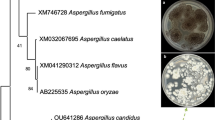Abstract
Although peracetic acid (PAA) is used widely for cold sterilization and disinfection, its mechanisms of sporicidal action are poorly understood. PAA at high concentrations (5–10%) can cause major loss of optical absorbance and microscopically-visible damage to bacterial spores. Spores killed by lower levels of PAA (0.02–0.05%) showed no visible damage and remained refractile. Treatment of spores ofBacillus megaterium ATCC 19213 with PAA at concentrations close to the lethal level sensitized the cells to subsequent heat killing. In addition, PAA was found to act in concert with hypochlorite and iodine to kill spores. Antioxidant sulfhydryl compounds or ascorbate protected spores against PAA killing. Trolox, a water-soluble form of α-tocopherol, was somewhat protective, while other antioxidants, including α-tocopherol, urate, bilirubin, ampicillin and ethanol were not protective. Chelators, including dipicolinate, were not protective, but transition metal ions, especially the reduced forms (Co2+, Cu+ and Fe2+) were highly protective. The net conclusions are that organic radicals formed from PAA are sporicidal and that they may act as reducing agents for spores that are normally in a highly oxidized state, in addition to their well known actions as oxidizing agents in causing damage to vegetative cells.
Similar content being viewed by others
References
Akaike T, K Sato, S Ijiri, Y Miyamoto, M Kohno, M Ando and H Maeda. 1992. Bactericidal activity of alkyl peroxyl radicals generated by heme-iron-catalyzed decomposition of organic peroxides. Arch Biochem Biophys 294: 55–63.
Aronson AI and D Horn. 1972. Characterization of the spore coat protein ofBacillus cereus. In: Spores V (Halvorson HO, R Hanson and LL Campbell, eds), pp 19–27, American Society for Microbiology, Washington DC.
Baldry MGC. 1983. The bactericidal, fungicidal and sporicidal properties of hydrogen peroxide and peracetic acid. J Appl Bacteriol 54: 417–423.
Beaman TC and P Gerhardt. 1986. Heat resistance of bacterial spores correlated with protoplast dehydration, mineralization, and thermal adaptation. Appl Environ Microbiol 52: 1242–1246.
Bender GR and RE Marquis. 1985. Spore heat resistance and specific mineralization. Appl Environ Microbiol 50: 1414–1421.
Block SS. 1991. Peroxygen compounds. In: Disinfection, Sterilization and Preservation (Block SS, ed), pp 167–181, Lea and Febiger, Philadelphia, PA.
Bloomfield SF and R Megid. 1994. Interaction of iodine withBacillus subtilis spores and spore forms. J Appl Bacteriol 76: 492–499.
Botzenhart K and R Jaax. 1985. Determination of the killing rate ofBacillus spores by peracetic acid. Zbl Bakt Hyg 181B: 139–150.
Buettner GR. 1993. The pecking order of free radicals and antioxidants: lipid peroxidation, alpha-tocopherol, and ascorbate. Arch Biochem Biophys 300: 535–543.
Clapp PA, MJ Davies, MS French and BC Gilbert. 1994. The bactericidal action of peroxides: an E.P.R. spin-trapping study. Free Rad Res 21: 147–167.
Curran HR, FR Evans and A Leviton. 1940. The sporicidal action of hydrogen peroxide and the use of crystalline catalase to dissipate residual peroxide. J Bacteriol 40: 423–434.
Gerhardt P, R Scherrer and SH Black. 1972. Molecular sieving by dormant spores structures. In: Spores V (Halvorson HO, R Hanson and LL Campbell, eds), pp 68–74, American Society for Microbiology, Washington DC.
Jones LA Jr, RK Hoffman and CR Phillips. 1967. Sporicidal activity of peracetic acid and β-propiolactone at subzero temperatures. Appl Microbiol 15: 357–362.
King WL and GW Gould. 1969. Lysis of bacterial spores with hydrogen peroxide. J Appl Bacteriol 32: 481–490.
Leaper S. 1984. Synergistic killing of spores ofBacillus subtilis by peracetic acid and alcohol. J Food Technol 19: 695.
Löwik JAM and PJ Anema. 1972. Effect of pH on the heat resistance ofClostridium sporogenes spores in minced meat. J Appl Bacteriol 35: 119–121.
Marquis RE and GR Bender. 1985. Mineralization and heat resistance of bacterial spores. J Bacteriol 161: 789–791.
Peck MW, DA Fairbairn and BM Lund. 1993. Heat-resistance of spores of non-proteolyticClostridium botulinum estimated in medium containing lysozyme. Lett Appl Microbiol 16: 126–131.
Pichorner H, G Jessner and R Ebermann. 1993. t-BOOH acts as a suicide substrate for catalase. Arch Biochem Biophys 300: 258–264.
Pryor WA. 1986. Oxy-radicals and related species: their formation, lifetimes and reactions. Annu Rev Physiol 48: 657–667.
Rodriguez-Montelongo L, LC de la Cruz-Rodriguez, RN Farías and EM Massa. 1993. Membrane-associated redox cycling of copper mediates hydroperoxide toxicity inEscherichia coli. Biochim Biophys Acta 1144: 77–84.
Setlow B and P Setlow. 1993. Binding of small, acid-soluble spore proteins to DNA plays a significant role in the resistance ofBacillus subtilis spores to hydrogen peroxide. Appl Environ Microbiol 59: 3418–3423.
Shin SY and RE Marquis. 1994. Sporicidal activity of tertiary butyl hydroperoxide. Arch Microbiol 161: 184–190.
Shin S-Y, EG Calvisi, TC Beaman, HS Pankratz, P Gerhardt and RE Marquis. 1994. Microscopic and thermal characterization of hydrogen peroxide killing and lysis of spores and protection by transitional metal ions, chelators, and antioxidants. Appl Environ Microbiol 60: 3192–3197.
Toledo RT, FE Escher and JC Ayres. 1973. Sporicidal properties of hydrogen peroxide against food spoliage organisms. Appl Microbiol 26: 592–597.
Wang P and HE Schellhorn. 1995. Induction of resistance to hydrogen peroxide and radiation inDeinococcus radiodurans. Can J Microbiol 41: 170–176.
Author information
Authors and Affiliations
Rights and permissions
About this article
Cite this article
Marquis, R.E., Rutherford, G.C., Faraci, M.M. et al. Sporicidal action of peracetic acid and protective effects of transition metal ions. Journal of Industrial Microbiology 15, 486–492 (1995). https://doi.org/10.1007/BF01570019
Received:
Accepted:
Issue Date:
DOI: https://doi.org/10.1007/BF01570019




